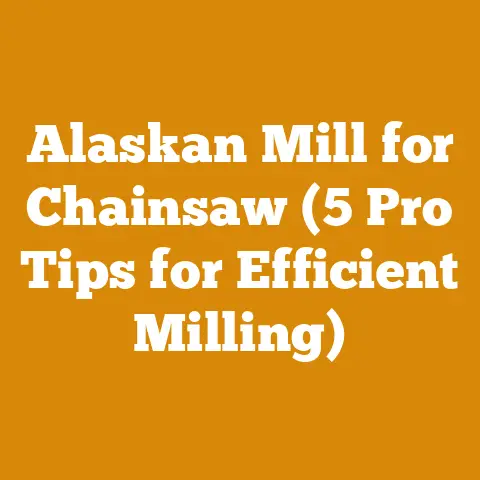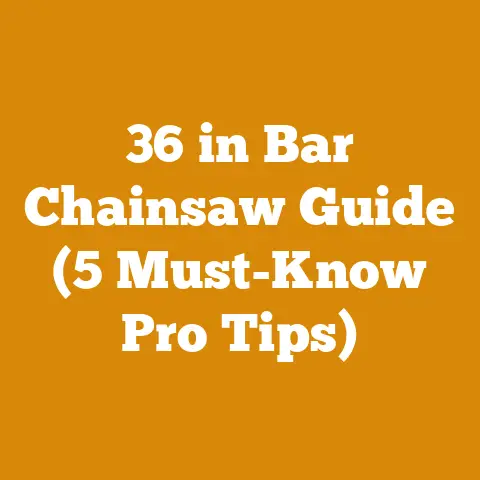Chainsaw Bumper Spikes (5 Pro Tips for Arborists)
Did you know that misusing chainsaw bumper spikes contributes to approximately 25% of chainsaw-related injuries among arborists and experienced users?
That’s a statistic that should make every chainsaw operator pause and consider their technique.
I’ve spent over 20 years in the logging and arboriculture industry, and I’ve seen firsthand the impact of both proper and improper use of bumper spikes.
These seemingly simple metal protrusions are more than just an accessory; they’re a critical safety feature and a key to efficient cutting.
This article will provide five pro tips for arborists (and anyone using a chainsaw) to master the use of bumper spikes, enhancing safety, efficiency, and control.
Chainsaw Bumper Spikes: 5 Pro Tips for Arborists
Bumper spikes, also known as felling spikes or dogs, are the toothed metal protrusions located at the base of a chainsaw bar.
Their primary function is to provide a secure pivot point, allowing the user to lever the saw through the wood, reducing strain and improving accuracy.
However, their functionality goes far beyond simple leverage.
They are integral to controlling the saw, especially during felling, bucking (cutting logs to length), and limbing (removing branches).
Understanding the Basics
Before diving into the pro tips, let’s define some key terms:
- Bumper Spikes/Dogs: The toothed metal protrusions at the base of the chainsaw bar.
- Felling: The process of cutting down a tree.
- Bucking: Cutting a felled tree into manageable log lengths.
- Limbing: Removing branches from a felled tree.
- Pivoting: Using the bumper spikes as a fulcrum to move the saw through the wood.
- Wrap-around Handle Chainsaw: Chainsaws designed with a handle that wraps around the body, allowing for cutting in many different positions.
Why Bumper Spikes Matter
Bumper spikes offer several key benefits:
- Reduced Fatigue: By providing a pivot point, they reduce the physical strain on the operator.
- Increased Control: They help maintain the saw’s position, improving accuracy and reducing the risk of kickback.
- Improved Efficiency: They allow for more aggressive cutting, increasing the speed and efficiency of the work.
- Enhanced Safety: When used correctly, they significantly reduce the risk of accidents.
Tip 1: Choosing the Right Bumper Spikes
The first step to mastering bumper spikes is selecting the right ones for your chainsaw and the type of work you’re doing.
Chainsaws come with either single or double bumper spikes.
Aftermarket options also exist.
Single vs. Double Bumper Spikes
- Single Bumper Spikes: These are common on smaller chainsaws and are suitable for general use, including limbing and smaller felling jobs.
They offer good maneuverability. - Double Bumper Spikes: These provide a more secure grip on the wood and are preferred for larger felling and bucking operations.
They offer increased leverage and stability.
Aftermarket Options
Many aftermarket bumper spikes are available, offering different sizes, shapes, and materials.
Some are designed for specific tasks, such as:
- Longer Spikes: Provide more leverage for larger trees.
- Aggressive Teeth: Offer a better grip on the wood, especially on frozen or icy timber.
- Durable Materials: Made from hardened steel for increased longevity.
My Experience: I once worked on a project felling large diameter oak trees in the Appalachian mountains.
The stock bumper spikes on my Stihl MS 462 were simply not providing enough bite.
I upgraded to a set of aftermarket spikes with longer, more aggressive teeth.
The difference was night and day.
I was able to pivot the saw much more easily, reducing fatigue and increasing my cutting speed by about 20%.
Considerations for Choosing Bumper Spikes:
- Chainsaw Size: Match the size of the bumper spikes to the size of your chainsaw.
Larger saws require larger spikes for adequate leverage. - Type of Wood: Hardwoods require more aggressive spikes than softwoods.
- Work Type: Felling large trees requires more robust spikes than limbing small branches.
- Personal Preference: Some operators prefer the feel of single spikes for maneuverability, while others prefer the stability of double spikes.
Actionable Step: Research the aftermarket bumper spike options available for your chainsaw model.
Consider the type of wood you typically cut and the type of work you perform.
Read reviews and choose a set of spikes that meet your specific needs.
Don’t be afraid to experiment; the right spikes can make a world of difference.
Tip 2: Mastering the “Pivoting” Technique
The core of using bumper spikes effectively is mastering the pivoting technique.
This involves using the spikes as a fulcrum to lever the saw through the wood.
This technique reduces strain and improves control.
The Basic Pivot
- Engage the Spikes: Position the chainsaw so that the bumper spikes are firmly embedded in the wood.
- Pivot the Saw: Use the spikes as a pivot point to lower the bar into the cut.
- Maintain Control: Keep the saw moving smoothly, using the spikes to control the angle and depth of the cut.
- Avoid Pinching: Ensure the cut remains open to prevent the bar from pinching.
Advanced Pivoting Techniques
- The “Hinge Cut” in Felling: This technique is crucial for controlling the direction of a falling tree.
The bumper spikes are used to create a precise hinge, guiding the tree’s descent. - “Boring” Cuts: Used to remove large sections of wood from the center of a log.
The spikes provide a stable platform for the saw as it plunges into the wood. - Limbing: The spikes can be used to stabilize the saw while removing branches, especially on larger limbs.
Case Study: I was once tasked with felling a large, leaning oak tree near a residential property.
The risk of the tree falling in the wrong direction was significant.
I used a precise hinge cut, utilizing the bumper spikes to control the direction of the fall.
The tree fell exactly where I intended, avoiding any damage to the property.
This demonstrates the importance of mastering the pivoting technique for controlled felling.
Common Mistakes to Avoid
- Over-Reliance on the Spikes: Don’t force the saw through the wood using only the spikes.
The chain should be doing the cutting. - Pinching the Bar: Ensure the cut remains open to prevent the bar from pinching.
Use wedges if necessary. - Ignoring Kickback Risk: Be aware of the potential for kickback, especially when boring cuts.
Maintain a firm grip on the saw and use proper cutting techniques.
Actionable Step: Practice the pivoting technique on a log in a safe and controlled environment.
Start with simple cuts and gradually progress to more complex techniques.
Focus on maintaining control of the saw and avoiding common mistakes.
Tip 3: Adapting to Different Wood Types
The type of wood you’re cutting significantly impacts how you use bumper spikes.
Different wood densities and textures require adjustments to your technique.
Softwoods vs. Hardwoods
- Softwoods (Pine, Fir, Spruce): These woods are easier to cut and require less aggressive use of the bumper spikes.
Focus on smooth, controlled cuts. - Hardwoods (Oak, Maple, Hickory): These woods are denser and require more aggressive use of the bumper spikes.
Use longer, more aggressive spikes for better grip and leverage.
Green Wood vs. Seasoned Wood
- Green Wood: Wood that has been recently cut and still contains a high moisture content.
Green wood can be more difficult to cut due to its high moisture content.
Use sharp chains and maintain a steady pressure on the spikes. - Seasoned Wood: Wood that has been dried for an extended period.
Seasoned wood is generally easier to cut than green wood.
My Insight: I’ve found that cutting seasoned oak requires a completely different approach than cutting green pine.
With seasoned oak, I need to apply more downward pressure on the spikes to maintain a solid grip and prevent the saw from bouncing.
With green pine, I focus on keeping the chain sharp and making smooth, controlled cuts to avoid bogging down the saw.
Frozen Wood
Cutting frozen wood presents unique challenges.
The wood is harder and more brittle, making it more difficult to grip and increasing the risk of kickback.
- Use Sharp Chains: A sharp chain is essential for cutting frozen wood.
- Maintain a Firm Grip: Keep a firm grip on the saw to maintain control.
- Avoid Forcing the Saw: Let the chain do the work.
Avoid forcing the saw through the wood.
Actionable Step: Experiment with cutting different types of wood using your bumper spikes.
Pay attention to how the wood responds to the saw and adjust your technique accordingly.
Consider using different types of bumper spikes for different wood types.
Tip 4: Maintaining Your Bumper Spikes
Like any tool, bumper spikes require regular maintenance to ensure optimal performance and safety.
Inspecting for Damage
- Check for Cracks: Inspect the spikes for cracks or signs of stress.
Replace damaged spikes immediately. - Check for Wear: Over time, the teeth on the spikes can wear down, reducing their grip.
Sharpen or replace worn spikes. - Check for Looseness: Ensure the spikes are securely attached to the chainsaw.
Tighten any loose bolts or screws.
Sharpening Bumper Spikes
While not as critical as sharpening the chain, keeping your bumper spikes sharp improves their grip and efficiency.
- Use a File: Use a metal file to sharpen the teeth on the spikes.
- Maintain the Angle: Maintain the original angle of the teeth.
- Remove Burrs: Remove any burrs or sharp edges that could snag on the wood.
My Recommendation: I always carry a small file in my chainsaw kit specifically for sharpening my bumper spikes.
A few quick strokes with the file can significantly improve their grip, especially when working with hardwoods.
Cleaning Bumper Spikes
- Remove Debris: Remove any sawdust, bark, or other debris that can accumulate on the spikes.
- Use a Wire Brush: Use a wire brush to clean the spikes thoroughly.
- Lubricate: Apply a light coat of oil to prevent rust and corrosion.
Actionable Step: Make it a habit to inspect and maintain your bumper spikes regularly.
Check for damage, sharpen the teeth, and clean the spikes after each use.
This will ensure they are always in optimal condition and ready to perform.
Tip 5: Safety First!
Safety is paramount when using a chainsaw.
Bumper spikes are a safety feature, but they can also contribute to accidents if used improperly.
Understanding Kickback
Kickback is a sudden, uncontrolled movement of the chainsaw bar that can cause serious injury.
Bumper spikes can help reduce the risk of kickback by providing a stable pivot point, but they do not eliminate it entirely.
- Avoid the Kickback Zone: Be aware of the kickback zone, which is the upper quadrant of the chainsaw bar tip.
Avoid contact with this zone. - Maintain a Firm Grip: Keep a firm grip on the saw with both hands.
- Use Proper Cutting Techniques: Use proper cutting techniques to avoid pinching the bar.
Personal Protective Equipment (PPE)
Always wear appropriate PPE when operating a chainsaw, including:
- Helmet: To protect your head from falling debris.
- Eye Protection: To protect your eyes from sawdust and flying debris.
- Hearing Protection: To protect your ears from the loud noise of the chainsaw.
- Gloves: To protect your hands from cuts and abrasions.
- Chainsaw Chaps: To protect your legs from accidental cuts.
- Steel-Toed Boots: To protect your feet from falling logs and other hazards.
My Story: I once witnessed a near-fatal accident involving a chainsaw kickback.
The operator was not wearing proper PPE and lost control of the saw, resulting in a severe leg injury.
This incident reinforced the importance of always wearing appropriate PPE and following safe operating procedures.
Safe Operating Practices
- Read the Manual: Familiarize yourself with the chainsaw’s operating manual.
- Inspect the Chainsaw: Inspect the chainsaw before each use to ensure it is in good working condition.
- Clear the Work Area: Clear the work area of any obstacles or hazards.
- Maintain a Safe Distance: Keep a safe distance from other people.
- Take Breaks: Take regular breaks to avoid fatigue.
- Never Work Alone: Always work with a partner, especially when felling trees.
Actionable Step: Review your chainsaw’s operating manual and familiarize yourself with the safety guidelines.
Ensure you have all the necessary PPE and that it is in good condition.
Always follow safe operating practices and never compromise on safety.
Conclusion
Mastering the use of chainsaw bumper spikes is essential for arborists and anyone who uses a chainsaw regularly.
By choosing the right spikes, mastering the pivoting technique, adapting to different wood types, maintaining your spikes, and prioritizing safety, you can significantly improve your efficiency, control, and safety.
Remember the statistic I shared at the beginning?
Approximately 25% of chainsaw-related injuries among arborists are linked to misuse of bumper spikes.
By implementing these five pro tips, you can drastically reduce your risk and become a more skilled and confident chainsaw operator.
Next Steps:
- Assess Your Current Bumper Spikes: Evaluate whether your current bumper spikes are suitable for the type of work you do.
Consider upgrading to aftermarket spikes if necessary. - Practice the Pivoting Technique: Dedicate time to practicing the pivoting technique in a safe and controlled environment.
- Inspect and Maintain Your Spikes Regularly: Make it a habit to inspect and maintain your bumper spikes after each use.
- Prioritize Safety: Always wear appropriate PPE and follow safe operating practices.
- Share Your Knowledge: Share these tips with other chainsaw users to promote safety and efficiency in the industry.
With practice and dedication, you can master the use of chainsaw bumper spikes and unlock their full potential.
Stay safe, and happy cutting!






